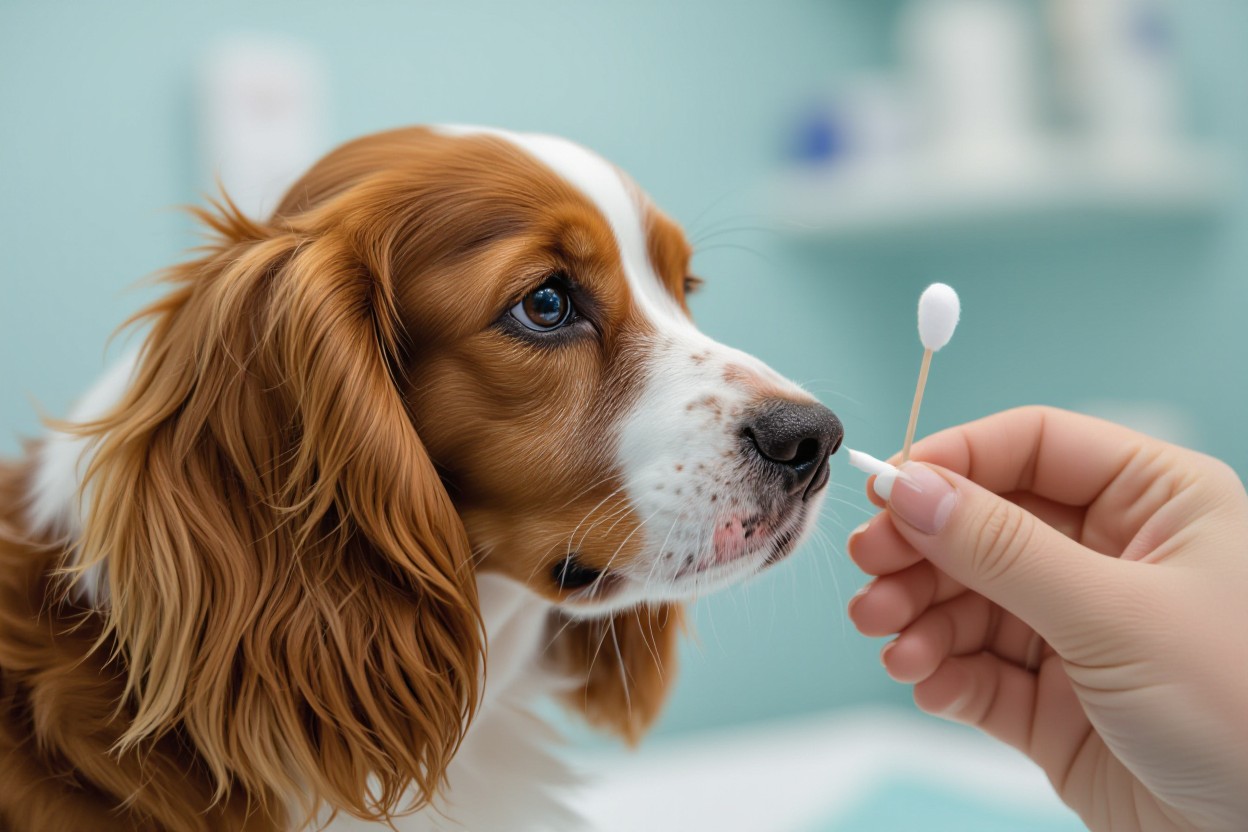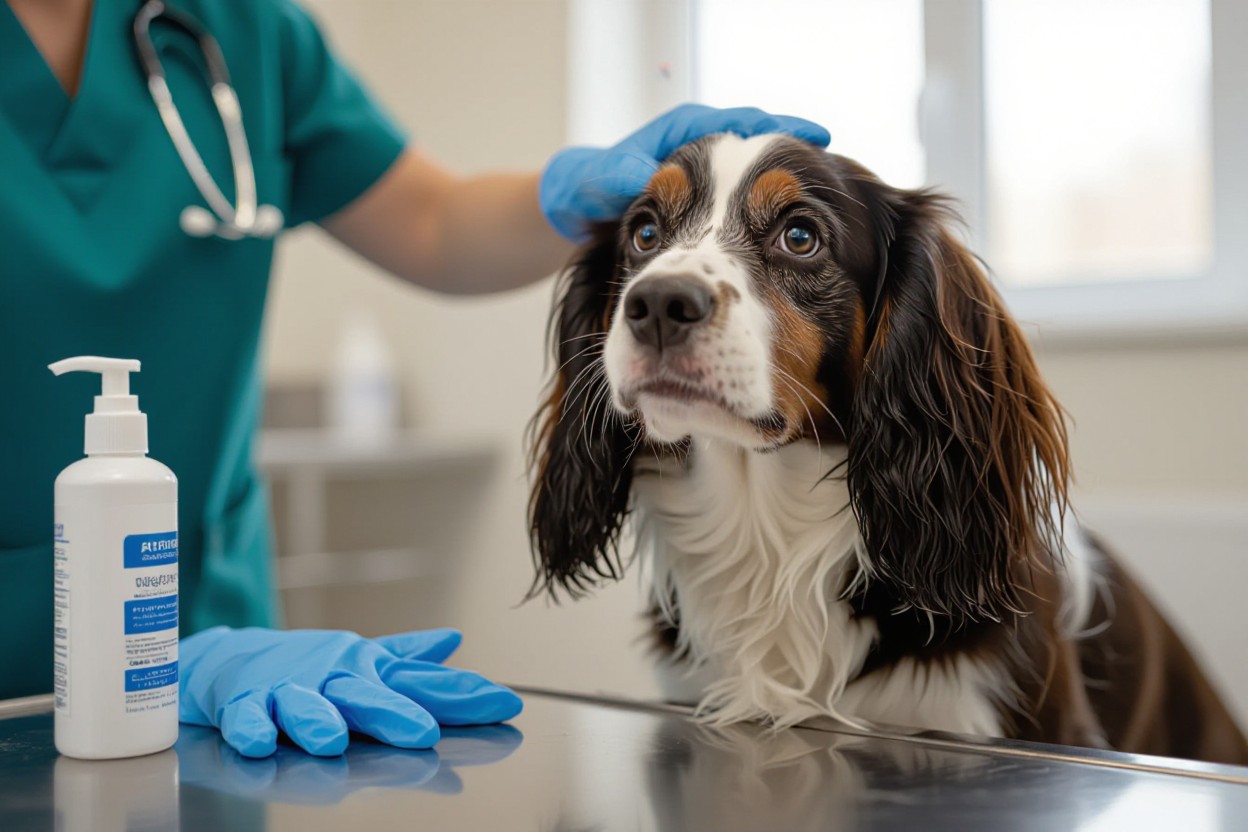Spaniel head shaking often indicates an ear problem; if your spaniel is shaking its head frequently, check for redness, discharge, foul odor, swelling, or head tilting and reduced balance. Understanding spaniel ear infection signs helps you decide when to try gentle cleaning versus seeking veterinary care. Cocker spaniel head shaking is common due to floppy ears trapping moisture, so act promptly to prevent worsening infection.
Understanding Spaniel Head Shaking
Common Reasons for Head Shaking
You’ll see spaniel shaking head for several predictable reasons: otitis externa (bacterial or yeast infections), ear mites, trapped water after swimming, foreign bodies like grass awns, allergy-related inflammation, or painful injuries. For example, after a pond swim your cocker may vigorously shake, scratch, and show brown discharge—classic spaniel ear infection signs that signal you should inspect the ear and consider a vet visit if symptoms persist more than 24–48 hours.
Anatomy of a Spaniel’s Ear
The spaniel ear combines long, floppy pinnae with a narrow external canal and the three standard ear compartments—outer, middle, inner—so airflow is limited and moisture gets trapped. As a result, breeds like the Cocker are prone to cocker spaniel head shaking and recurrent infections because wax, hair, and debris sit against the eardrum more easily than in erect-eared dogs.
Because the vertical and horizontal canals form an L-shape, debris and pathogens concentrate deep in the canal where you can’t see them; vets often use an otoscope to spot otitis externa and identify Malassezia (yeast), Staphylococcus, or Pseudomonas infections. In practice, frequent swimming, humid climates, or underlying allergies multiply risk, so tracking spaniel ear infection signs—odor, discharge, swelling, and repeated head shaking—helps you act faster.
Ear Infections in Spaniels
Types of Ear Infections
You’ll encounter bacterial, yeast, parasitic and middle-ear infections in spaniels; a cocker spaniel’s long, floppy ears trap moisture and debris, so you often see recurrent cases after swimming, grooming, or allergy flares. The severity and treatment vary by agent and whether the infection is acute or chronic.
- Bacterial otitis externa — foul-smelling discharge, pain, often responds to topical antibiotics after cytology.
- Yeast (Malassezia) — brown, crumbly debris with a yeasty odor, common in humid conditions.
- Ear mites — intense scratching, dark granular debris, common in puppies and multi-dog households.
- Otitis media — head tilt, facial pain, often follows untreated external infection or a ruptured tympanic membrane.
| Type | Typical signs & common treatment |
| Bacterial otitis externa | Smell, purulent discharge; treat with topical/systemic antibiotics guided by cytology/culture |
| Yeast otitis | Brown waxy debris, itching; antifungal ear washes and topical azoles |
| Otitis media | Head tilt, pain, secondary vestibular signs; requires imaging and systemic antimicrobials or surgery |
| Ear mites | Intense scratching, dark debris; treat with parasiticides and environment control |
Causes of Ear Infections
You’ll find several repeating drivers: trapped moisture from swimming or bathing, allergic skin disease (atopic or food-related), anatomic factors like narrow, hairy canals in cocker spaniels, and foreign bodies such as grass awns. In one clinic series, 62% of spaniels with recurrent otitis had a history of swimming or chronic allergic dermatitis, so you should check these first.
Digging deeper, common pathogens include Staphylococcus pseudintermedius and Pseudomonas for bacterial cases and Malassezia pachydermatis for yeast; endocrine issues like hypothyroidism alter ear skin defenses and raise infection risk. You should perform cytology at the first visit, consider culture if treatment fails, and investigate underlying allergies or endocrine disorders when infections recur — in a referral sample, 45% of recurrent cases required allergy workup to control “spaniel ear infection signs.”
Warning Signs of Ear Infections
Excessive Head Shaking
If your spaniel shakes its head more than five times in a minute or does repeated bouts throughout the day, that escalation often points to irritation or a foreign body. With cocker spaniel head shaking you’ll often see side-to-side swipes following swimming or grooming; note frequency, side preference, and any concurrent scratching to report to your vet.
Scratching or Rubbing Ears
When your dog repeatedly paws at a single ear or rubs it along the floor, that localized behavior is a common spaniel ear infection sign. It often follows exposure to water, pollen, or prolonged wax buildup and tends to worsen overnight or after exercise.
Check for hair loss, scabs, or broken skin from persistent scratching; vigorous pawing can cause an aural hematoma within days. If you see bleeding, chronic thickening, or worsening sensitivity when you touch the ear, photograph the area and seek veterinary assessment promptly.
Unpleasant Odor from Ears
A strong, musty or rancid smell coming from your spaniel’s ear is a reliable red flag for bacterial or yeast overgrowth. If the odor is noticeable from an arm’s length away or lingers after a basic wipe, include that detail when discussing spaniel ear infection signs with your vet.
Different smells hint at different organisms: a sweet, yeast-like aroma often suggests Malassezia overgrowth, while a foul, putrid odor leans toward gram-negative bacterial infection. Your vet will likely perform cytology and, if recurrent, a culture to identify the cause and guide treatment.
Redness and Swelling
Visible redness, warmth, or puffiness of the pinna or ear canal indicates active inflammation. If one ear looks notably redder or the canal appears narrowed compared with the other, document this as it’s a straightforward sign vets use when evaluating otitis externa.
On palpation your spaniel may pull away or yelp; chronic inflammation can lead to thickening and canal stenosis over weeks to months. Early intervention reduces the risk of permanent tissue changes and the need for more invasive procedures.
Discharge from the Ears
Any brown, yellow, bloody, or dark grainy discharge is abnormal and often accompanies infection. Clear fluid after vigorous head shaking can be minor, but purulent or gritty debris — especially if persistent beyond 24–48 hours — warrants veterinary attention.
Types of discharge offer clues: fecal-like black granules may indicate ear mites (common in puppies), while creamy or greenish pus suggests bacterial infection. Photograph the discharge, note onset and side affected, and bring samples or images to your appointment for faster diagnosis.
Home Checks for Ear Health
For a quick primer on causes, see Why is My Dog Shaking Its Head? 8 Possible Causes.
Visual Examination of Ears
Pull the ear flap up and look into the outer canal with good light: you want pale-pink skin, minimal wax, and no swelling. If you spot redness, thick brown or yellow discharge, or areas that look ulcerated, those are common spaniel ear infection signs and warrant fast action—especially with a spaniel shaking head repeatedly.
Checking for Dirt and Debris
Gently check the entrance of the ear for mud, grass, or large wax clumps after walks or swimming; use a cotton ball only on the visible crease and avoid probing. Persistent debris, especially after wet-field work, increases risk of infection in breeds like cocker spaniels.
When you remove visible dirt, moisten a cotton ball with sterile saline or a vet-approved ear cleanser and wipe the folds and the pinna—never insert swabs deep into the canal. Clean after heavy activity (for example, weekly during hunting season or immediately after a pond swim). Stop and book a vet appointment if cleaning causes pain, bleeding, or you uncover thick discharge.
Smell Test: What to Look For
Cup the ear near your nose and note any scent: healthy ears have little to no odor. A sweet, musty smell or a strong foul, rotten odor are both red flags and common in dogs showing cocker spaniel head shaking and other infection signs.
A yeasty, sweet smell often points to Malassezia (yeast) overgrowth and usually coincides with brown, crumbly wax and itching; a putrid or rancid smell suggests bacterial infection and more aggressive inflammation. If the odor is strong or paired with head shaking, discharge, or swelling, contact your vet—antifungal drops or antibiotics may be needed after cytology confirms the cause.
When to Consult a Veterinarian
If your spaniel shaking head doesn’t improve within 24–48 hours or you spot worsening discharge, a foul odor, or blood, book a vet visit. For basic guidance on itchy ears and prevention you can check Itchy ears and head shaking in dogs, but persistent or severe signs need professional assessment.
Signs That Require Immediate Attention
If your dog shows a head tilt, loss of balance, sudden deafness, facial paralysis, severe swelling around the ear, heavy bleeding, or intense pain, seek emergency care. These are not typical spaniel ear infection signs and may indicate middle‑ear involvement or neurological spread—especially with a cocker spaniel head shaking violently or repeatedly.
Diagnostic Tests for Ear Infections
Your vet will perform an otoscopic exam and take ear swabs for cytology to look for yeast or bacteria; cytology gives results immediately. If infection is recurrent or severe they’ll send a bacterial culture and sensitivity (results in 48–72 hours), and may recommend imaging or referral for persistent cases where otitis media is suspected.
In more detail, cytology uses a microscope to identify Malassezia (budding yeast), cocci, or rods, guiding initial topical therapy. Culture and sensitivity is indicated after recent antibiotic use, treatment failure, or deep infections; it determines the exact antibiotic and can prevent resistance. For chronic or neurological signs your vet might perform radiographs or CT and, under sedation, assess the tympanic membrane or perform myringotomy to sample the middle ear directly. Results from culture typically take 48–72 hours, so initial treatment is often empirical then refined once lab data returns.
Treatment Options for Ear Infections
Medications and Their Uses
You’ll commonly see topical antibiotics (gentamicin, neomycin), antifungals (miconazole, clotrimazole) and anti-inflammatory ear drops used first-line for otitis externa; systemic antibiotics such as amoxicillin–clavulanate or cephalexin are reserved for deep or chronic infections and are typically given for 7–14 days, sometimes up to 4 weeks in severe cases. Ear flushing and culture guide therapy for recurrent cases, and combination topical antifungal+steroid courses of 7–21 days often resolve yeast-dominated infections in breeds prone to cocker spaniel head shaking.
At-Home Care Tips
You should dry your spaniel’s ears after swimming or bathing, clean only with vet-approved solutions, and never insert cotton swabs into the canal; apply prescribed drops exactly as directed (usually once or twice daily for 7–14 days) and log doses and symptoms so you can report changes. If you see worsening discharge, a foul odor, or persistent spaniel shaking head beyond 48 hours, contact your vet.
- Dry ears thoroughly with a soft towel and use a low-heat hairdryer 10–20 cm away for 15–30 seconds per ear.
- Use a cotton ball with vet-approved cleaner to wipe visible wax—do not probe the canal.
- Give medications on schedule; missed doses increase relapse risk.
- Perceiving persistent odor, discharge, or worsening head shaking, call your vet immediately.
In recurrent or allergy-driven cases, set a weekly inspection and photographic log of any discharge or redness so you can track progression; clean lightly every 7–14 days only when advised, and arrange professional grooming every 6–8 weeks to trim inner ear hair that traps moisture. If your spaniel has environmental or food allergies—factors implicated in up to 60–70% of chronic otitis in some spaniel populations—discuss elimination diets or immunotherapy with your vet to reduce flare frequency and spaniel ear infection signs.
- Inspect ears after swims or hikes for redness, swelling, or brown/black debris.
- Schedule grooming to keep ear hair trimmed and reduce moisture trapping every 6–8 weeks.
- Perceiving repeat infections despite home care, request cytology, culture, or specialist referral.
Preventative Measures
You can reduce recurrence by keeping ears dry, managing allergies or skin disease, and performing weekly ear checks while cleaning only as your vet advises—overcleaning disrupts normal flora. Noting spaniel ear infection signs such as odor, frequent rubbing, or brown discharge and addressing them early lowers chronic risk; many vets recommend annual professional ear exams for breeds prone to otitis to help prevent future cocker spaniel head shaking episodes.
Adopt a maintenance plan: check ears weekly and clean with a vet-recommended solution every 2–4 weeks if wax builds up, dry ears immediately after water exposure (towel-dry then low-heat hairdryer for 15–30 seconds), and keep grooming appointments to trim inner ear hair every 6–8 weeks. If you notice spaniel shaking head persisting despite these measures, escalate to a vet visit and consider allergy testing; studies and clinical experience show that proactive management can halve recurrence rates in predisposed spaniels.
Conclusion
Drawing together, if you notice spaniel shaking head or other spaniel ear infection signs, you should inspect for redness, odor, discharge and discomfort, perform gentle home checks only when safe, and seek prompt veterinary care—especially with cocker spaniel head shaking or intense pain—to ensure accurate diagnosis, effective treatment, and to prevent chronic problems.
FAQ
Q: Why is my spaniel shaking its head?
A: Head shaking in spaniels commonly signals ear irritation. Causes include otitis externa or media (bacterial or fungal infection), ear mites, trapped water or foreign bodies, excessive wax, allergic inflammation, or pain from a lodged object. Less commonly it can be vestibular or neurological disease. Observe other signs before assuming infection.
Q: What are the main spaniel ear infection signs I should watch for?
A: Key spaniel ear infection signs are repeated head shaking, persistent pawing at the ear, foul or strong odor, visible discharge (brown, black, yellow or green), redness or swelling of the ear canal, heat or soreness when you touch the ear, rubbing on furniture, tilting the head, and decreased response to sounds. Chronic cases may show thickened skin, hair loss around the ear, or scabs.
Q: My cocker spaniel keeps shaking its head—is that breed-related?
A: Yes. Cocker spaniels are prone to ear problems because their long, floppy ears limit airflow and trap moisture and debris; dense hair in the ear canal can also trap material and encourage infections. That makes recurrent otitis and persistent cocker spaniel head shaking more likely than in some other breeds.
Q: How can I safely check my spaniel’s ears at home?
A: Gently lift the ear flap and look into the ear with a flashlight for discharge, redness, swelling, foreign material, or an odor. Avoid inserting anything into the ear canal; do not use cotton swabs deep inside. If the ear is painful, bleeding, or you see a foreign body, stop and contact your vet. Note what you see so you can describe it to your veterinarian.
Q: What immediate home steps can I take if I suspect an ear infection?
A: Wipe visible debris from the outer ear with a soft, damp cloth and dry the area thoroughly; keep the dog from swimming or bathing until evaluated. Do not apply over-the-counter antibiotics, hydrocortisone creams, or human eardrops unless directed by a vet. If the dog shows severe pain, bleeding, fever, or neurological signs, seek veterinary care immediately.
Q: When should I take my spaniel to the vet for ear problems?
A: See a vet promptly if signs persist beyond 24–48 hours, if the ear is painful, if there is bloody or green discharge, a strong foul smell, recurrent episodes, swelling that closes the ear canal, head tilt, facial droop, or sudden hearing loss. Urgent care is needed for severe pain, bleeding, or neurological signs.
Q: How will the vet diagnose and treat the infection, and how can I prevent recurrences?
A: The vet will examine the ear with an otoscope, take swabs for cytology and possibly culture, and check for foreign bodies or deeper infection. Treatment typically involves ear-cleaning or flushing, prescription topical antimicrobials or antifungals, and sometimes oral antibiotics or anti-inflammatories; chronic severe cases may require a sedated flush or surgery. To reduce recurrence: keep ears dry after swimming/bathing, remove excess hair in the ear canal if recommended by a groomer or vet, perform routine ear checks and cleaning with a vet-approved solution, manage allergies or skin disease, and follow up if infections recur.


